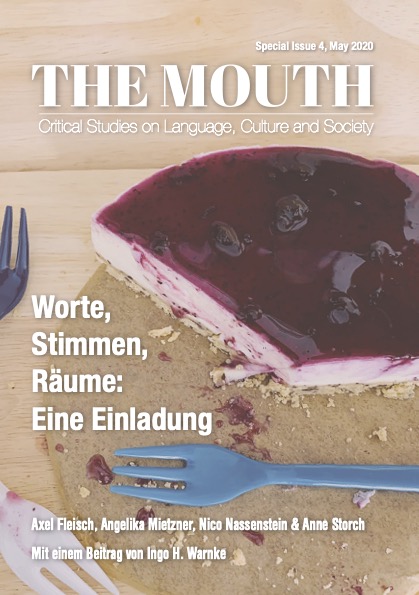Bewegung in viele Richtungen: Eine Einladung zur kritischen Afrikanistik
DOI:
https://doi.org/10.18716/ojs/the_mouth.3171Abstract
Das Denken über Sprache ist in gewisser Weise an das Denken über Raum gebunden; Sprechen über Sprache ist die Rede über Welt, und beides – Wort und Raum – fallen immer wieder zusammen. Und ohne die Erfahrung der Überquerung von Räumen, dem Übertreten von Grenzen, dem Durchschreiten von Welt, ist es unmöglich, die eigenen Möglichkeiten des Sprechens und Erkennens zu begreifen. Umso bemerkenswerter erscheint es, dass in der Linguistik, vielleicht besonders dort, wo sie sich mit außereuropäischen Sprachen befasst wie es die Afrikanistik tut, überwiegend eine Realität konstruiert wird, in der die Bewegung die Ausnahme, das Besondere, darstellt. Die Beobachtung der Dynamizität von Sprache evoziert Forschung über Kontakt, Varietät, Entlehnung, Wandel usw., wenngleich die Idee einer Sprache, die ein in sich geschlossenes System bildet und strukturell ungewandelt vor sich hin existiert, die viel verrücktere Vorstellung zu sein scheint. Aber so wird das nicht gedacht in der Sprachwissenschaft von den Sprachen dieser Welt in der alles seinen Platz auf der Sprachenkarte hat, typologisch sortiert und historisch eingeordnet werden muss. Die Frage Édouard Glissants (1997) nach dem Recht auf Opazität, der Normalität des Nichtverstehens im Kontrast zur Barbarei des Entschlüsselns und Fixierens, ist in der Afrikanistik wie auch anderswo in der Sprachwissenschaft für keinen ernstzunehmenden Vorschlag gehalten worden. Gleichzeitig bietet die Geschichte der Disziplin wie auch das System, in dem wir heute leben müssen, allerhand Grund, sich mit dieser Idee und den Erfahrungen der Entortung ernsthaft auseinanderzusetzen.

Downloads
Published
Issue
Section
License

This work is licensed under a Creative Commons Attribution 4.0 International License.
CC BY 4.0 deed
https://creativecommons.org/licenses/by/4.0/deed.en
You are free to:
- Share — copy and redistribute the material in any medium or format for any purpose, even commercially.
- Adapt — remix, transform, and build upon the material for any purpose, even commercially.
- The licensor cannot revoke these freedoms as long as you follow the license terms.
Under the following terms:
- Attribution — You must give appropriate credit , provide a link to the license, and indicate if changes were made . You may do so in any reasonable manner, but not in any way that suggests the licensor endorses you or your use.
- No additional restrictions — You may not apply legal terms or technological measures that legally restrict others from doing anything the license permits.
Notices:
You do not have to comply with the license for elements of the material in the public domain or where your use is permitted by an applicable exception or limitation .
No warranties are given. The license may not give you all of the permissions necessary for your intended use. For example, other rights such as publicity, privacy, or moral rights may limit how you use the material.Notice
This deed highlights only some of the key features and terms of the actual license. It is not a license and has no legal value. You should carefully review all of the terms and conditions of the actual license before using the licensed material.
Creative Commons is not a law firm and does not provide legal services. Distributing, displaying, or linking to this deed or the license that it summarizes does not create a lawyer-client or any other relationship.
Creative Commons is the nonprofit behind the open licenses and other legal tools that allow creators to share their work. Our legal tools are free to use.





